 |
 |
|
 |
 |
 |
|
 |
Whirlpool Washer Repair

Appliance repair
>
Washers
>
Whirlpool Washer >
Testing/Replacing water inlet valve
READ THIS FIRST!
Warning! To avoid personal
injury or death, always unplug the appliance or disconnect the power before
attempting any repairs. Always turn off the gas at the source before repairing
any gas appliance. Always wear safety glasses when using tools. Keep loose
clothing and hair away from any moving parts. Safety is of major importance when
performing any service or repair on any electrical appliance.
By reading this page you state that you have read and agreed to RepairAve.com's
Disclaimer and Terms of Use. |
Testing and Replacing Water Inlet Valve
Whirlpool® washing machines (direct drive)
|
|
 |
| Instructions |
Illustrations |
 Disconnect
power to the washer (or unplug it). Turn off both hot and cold water lines
at the wall shut off valve. Disconnect
power to the washer (or unplug it). Turn off both hot and cold water lines
at the wall shut off valve. |
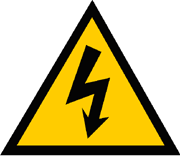 |
Except for some newer
models, the most common type of water valve used is the two-coil valve.
On portable washers the bottom port is blocked off and is not used. In
using one coil, it is called a single-coil inlet mixing valve. Adjustments
to hot and cold water are made at the faucets at your kitchen sink.
On other washers the two-coil inlet mixing valve is used and is actually
mixing the hot and cold water at the valve.
An "H" (hot) and "C" (cold) will be found stamped on the back of the panel
to assist in properly positioning the inlet mixing valve and inlet hoses.
Click here for the most common Whirlpool washer inlet valve, or enter
your washer model number in the search box below. |
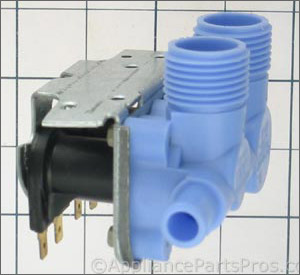 |
Testing the water inlet
valve
 Before testing, lets do the following: Before testing, lets do the following:
- First, disconnect power to the washer (or unplug it)
Note: Do not use the console as a hand support when moving the appliance
- Move the washer away from the wall so you can work on it.
- Use the
Removing washer cabinet article
to help you get to the valve.
1. Remove one wire connector at a time, carefully labeling each
connector according to the terminal marking or location on the inlet
mixing valve. This procedure should assure that the right connector is
reconnected to the right terminals.
2. Refer to the instructions that came with your ohmmeter to find
the proper scale to measure 100-1,000 ohms. Set the ohms scale and ZERO
the meter.
3. Touch and hold one of the ohmmeter probes to one of the
terminals on the coil
4. Touch the other ohmmeter probe to the other terminal on the same
coil.
5. You should read between 100-1,000 ohms. If you do not get this
reading, the inlet mixing valve is bad and needs to be replaced.
6. If your inlet mixing valve has two or three coils, check these
coils the same way as in steps 3-5.
Note: If you get this reading, the inlet valve could still be bad
from a mechanical problem inside the valve. Replace the inlet valve or
have this condition checked by a certified appliance technician. |
 |
 To find the right
water inlet valve for your washer, enter the washer model number below To find the right
water inlet valve for your washer, enter the washer model number below
(where is the model number?)
|
Removing the water
inlet valve
1. Shut off the hot and cold water faucets.
2. Identify the hot and cold water inlet hoses with a piece of tape. This
procedure will be easier when placing them back on the ports on the new
inlet mixing valve.
Note: Care should be taken when removing hoses as they may have
water in them.
3. Using pliers, remove the top (cold) from the inlet mixing valve port.
4. Using pliers, drain the excess water from this hose.
5. Using pliers, remove the bottom hose (hot) from the inlet mixing valve
port.
6. Using a pail, drain the excess water from this hose.
7. Using pliers, slide the clamp on the vacuum hose off the inlet mixing
valve port.
8. Remove the hose from the inlet mixing valve port.
9. Using a screwdriver or nutdriver, remove the screws which hold the
inlet mixing valve to the rear plane.
10. Carefully remove the inlet mixing valve.
|

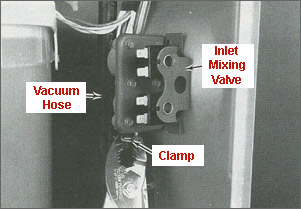
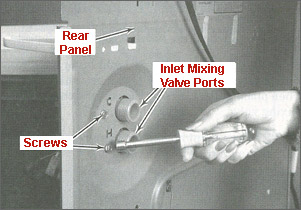 |
Installing the water
inlet valve
1. Place the new inlet mixing valve ports through the holes from inside
the rear panel.
2. Using a screwdriver or nutdriver, insert the screws through the rear
panel into the inlet mixing valve and tighten.
3. Slide the vacuum hose over the port on the inlet mixing valve.
4. Using pliers, side the clamp on this hose over the port.
5. Using the pliers, hand turn one of the hoses (until tight) onto one of
the ports on the inlet mixing valve; then turn 1/4 turn with the pliers to
tighten.
6. Using the pliers, hand turn the other hose (until tight) onto the
other port on the inlet mixing valve; then turn 1/4 turn with the pliers
to tighten.
7. Using pliers, attach the inlet hoses to the proper ports on the inlet
mixing valve.
8. Reconnect the wire connectors to the proper terminals as previously
marked.
9. Turn the hot and cold water faucets ON and check for leaks.
10. Use the
Re-installing the cabinet article
to help you put the washer back together.
Note: Do not use the console as a hand support when moving the
appliance.
11. Move the automatic washer back to its proper place.
12. Plug in washer or reconnect power. |
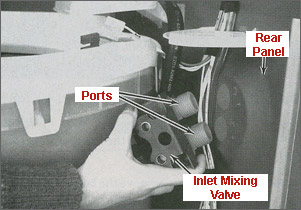
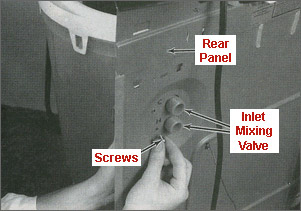
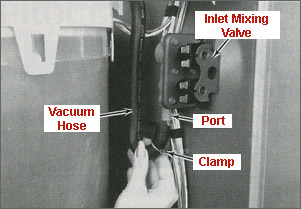
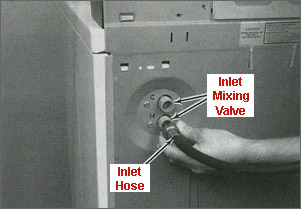 |
 |
- Troubleshooting guide
-
How washers work
- Removing washer cabinet (Taking your washer apart)
- Replacing timer knob
- Testing/Replacing water level switch
- Testing/Replacing water inlet valve
- Replacing water inlet hoses
- Repairing agitator problems
- Replacing drive block
- Checking/Replacing water pump
- Testing/Replacing motor switch
- Checking/Replacing motor drive coupling
- Testing/Replacing washer drive
motor
If your problem is not listed, try
this site.
|
|
|
 |
|
 |





